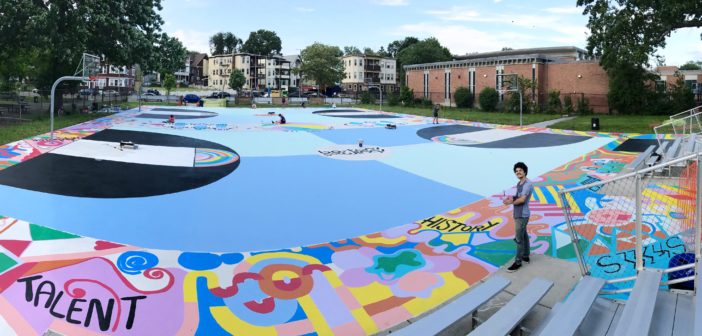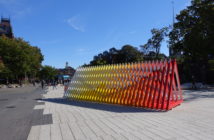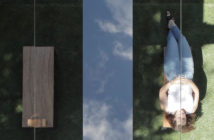Maria Molteni is a Boston-based artist who was a part of the Boston Artist in Residence program from 2016 - 2017. She is also the founder and team captain of the New Craft Artists in Action, a collective that looks at the intersections of art and sports with creative and social action. Her artistic practice and community presence are characterized by energy and color. Molteni works in creative expression across all media, and brings sports into this fold seamlessly through her chosen media, subjects, and collaborative focus on teamwork.
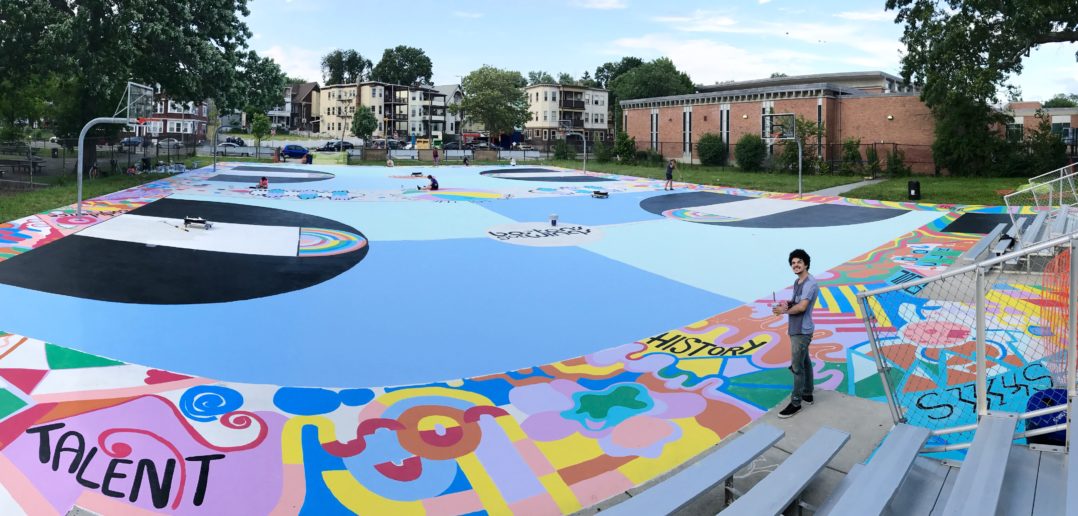
Photograph courtesy of Maria Molteni.
How did this project take form?
When I was accepted as an artist-in-residence for Boston AIR, I was paired with the BCYF Perkins Center in Dorchester, greatly due to their excellent basketball program and my work involving athletics. I started the residency on the 125th anniversary of the birth of basketball in Springfield, Massachusetts. It was also the 125th anniversary of Franklin Field, now Harambee Park, that neighbors the Center. There was a strong connection between both the Perkins community and our whole region to the history of this sport. Additionally, I learned that Harambee is slowly being renovated. We had the perfect opportunity to insert ourselves into that process and encourage the community to advocate for what they wanted to see in their park. Harambee is a Swahili phrase that means "all pull together.” It’s used in Kenya to refer to a tradition of community self-help events, which was apt given the community’s enormous collaborative efforts on this project.
How did you begin working with this community as a complete newcomer?
It was important to me to get to know members of the Perkins Center and build an atmosphere of trust. The final project was only part of a long process and relationship. I hosted weekly workshops with youth, teens and the Pee-Wee Basketball Saturday families who came from all over the city. We started with material and conceptual icebreakers, such as asking the students to list their dream mascots (which ranged from the Black Panthers to unicorns). We made lists of athletic ephemera- balls, nets, jerseys, sneakers, pom-poms, scoreboards and so on- as if they were ingredients in a dish. We discussed how these elements might be reimagined and how we might rewrite the rules of the game according to our own values. We produced zines and other projects that reflected our brainstorming phases.
It was clear that a tangible goal would give us a framework within which the creativity of each student could shine. I asked my students and many of their parents if they wanted to design a basketball court. Their enthusiasm made the decision clear. Painting a whole court has always been a dream of mine. I’m thankful so many amazing young artists shared this vision.
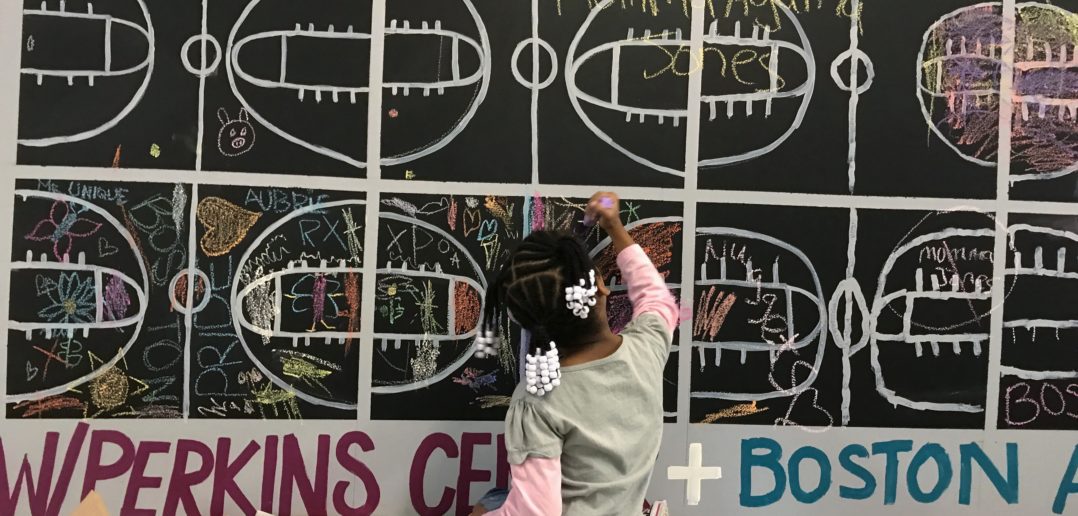
Photograph courtesy of Mara Molteni.
What were your aesthetic goals for this project? How do you balance your artistic vision when working with so many people and moving parts?
An artist often has her own aesthetic perspective or intuitive toolkit at the ready, but I try to approach aesthetics contextually and let go of the reins a bit. Through collaboration, I hope to expand the way I think about form, color, space, style, and culture. In my personal work, I appropriate certain palettes and visual language to reference pop culture and design throughout the athletic industry’s history. In the late 80s to early 90s, athleticwear started adopting action painting motifs into its visual language, connecting painting to movement and performance in a marriage of the art and athletic worlds. Bright colors are important to athleticwear. This isn't something that needs to be sold or explained to kids. At a young age, most of my students find power in their intuitive use of color. I believe color and aesthetics encourage people to rethink what they are used to seeing and subscribing to. It’s liberating, celebratory and complex.
The execution was designed to be intuitive and process-based. There wasn’t a specific expectation from the outset. We hardly had a master design to start with besides the big basketball in the center (designed by Perkins teen Sa’mya Givan), which the teen girls had advocated for. An amazing team of artist colleagues and community members were given the freedom to translate students’ drawings into labyrinthine, painterly areas of discovery and play beyond traditional court lines. We described it as activating the margins. I was there guiding the general structure of our labor, engaging with curious neighbors, training kids on paint rollers and luring others to the brush. It was a juggling act, but this made for a rich and authentic community process. I encouraged my students to explore without feeling limited to the symbols of sports teams and other logos that they’re often inundated with.
You and the community created an artwork that would long outlast your daily involvement with them. What did you want to ultimately leave behind?
I hoped our creation would encourage continued curiosity, exploration, and questioning of what we’re used to seeing in the public realm and how we express our values. Oftentimes public works illustrate a specific historic figure or event. Particularly in the arenas of sports and politics, I feel this approach can be limiting, putting an individual (and oftentimes a problematic one) on a pedestal rather than celebrating the whole community. I wanted to honor the kids’ enthusiasm for their sports heroes but encourage them to tap into their shared power as neighbors, teammates and friends. I wanted to leave behind an inclusive space that could be used in many ways and admired by all as an enormous work of art that provides everyone a sense of ownership and pride. I also wanted civic bodies in Boston to see what is possible when artists and initiatives like Boston AIR are supported.
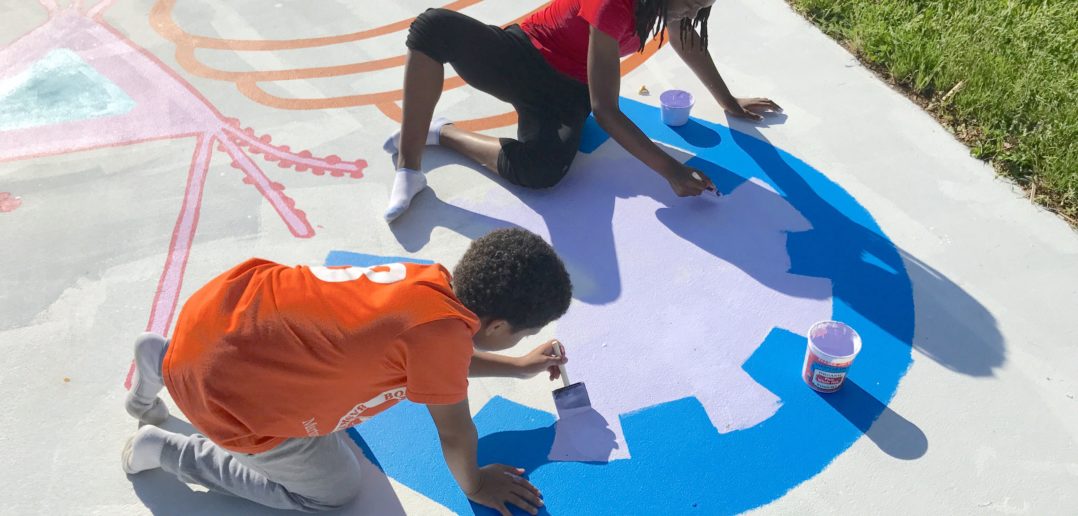
Photograph courtesy of Maria Molteni.
You have a strong background in both individual studio art and socially-engaged community artwork. Discussions of aesthetics and values differ greatly between individual studio art and community art. What are your thoughts on this split and moving between these spaces?
I see the polarization of “studio” and “social” art practices to be problematic. A successful artist must learn from the world and their communities as they hone a deeper understanding of themselves. It’s not always a quick or direct shot. Repeated socially engaged blockbusters without time for private contemplation and experimentation can be very risky.
I also believe that most successful projects start from personal investigation and manipulating materials. This physical and intellectual research can then expand outward via the reciprocal exchange of knowledge, values, and experiences between parties. Social practice art is exciting because it pushes the boundaries of what art can be. It challenges traditional notions of the art object and the idea of the solitary genius artist by bringing community and political action into art, sometimes making both more accessible to a greater public.
Traditional aesthetic criteria cannot be applied to socially engaged works in the same way as it can to studio art practice, but formal concerns are still applicable to social, political, and spiritual conversation. For example, exploring abstraction is as relevant to societal patterns as it is the self and one’s place in society. However, the aesthetic criteria shift when the context is more socially complex. Ethics and accountability play into each aesthetic decision as an artist runs the risk of using people as a medium. Aesthetics are not entirely abandoned, but they reflect the context and dynamics of all the people involved.
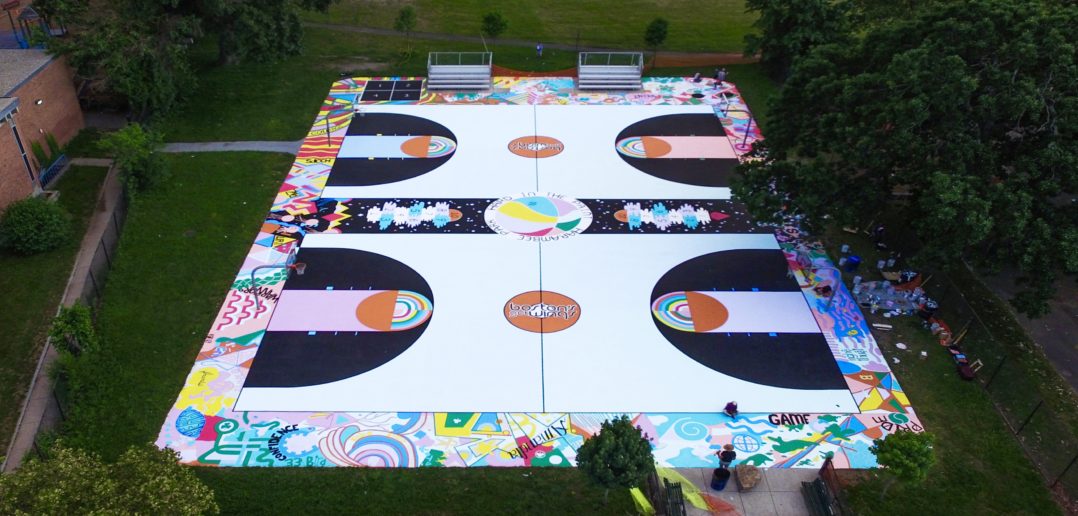
Photograph courtesy of Jesse Abbruzzese.
What are some aspects of socially-engaged artwork that you believe need improvement?
In some community and public art programs, an artist’s strongest assets may be undervalued while they are asked to perform in ways they are less prepared for. Artists are sometimes asked to fill in as social workers, but without getting proper training to be successful and accountable in this context. This also undervalues the expertise of folks trained in these fields. There should be more cross-disciplinary discussion to give both parties the tools they need to work well together. I do believe the ability of artists to carefully observe makes them equipped to creatively problem-solve and tap into social patterns that others might not see, but we need to be mindful, informed, and prepared to enter new communities.
Another critique is that social practice artists are often expected to be extroverted and constantly moving, talking, and producing in a public way. I don’t believe that all worthwhile social endeavors must be so externalized and highly visible. Quiet, intimate experiences nurture and shape us as much as the big and bold. Much of this field of work relies on grants and measurable data, but we need to learn to appreciate art for its own sake and the immeasurable effects it has on our lives. We shouldn’t force it to be legitimized by other disciplines. I find this especially relevant in Boston.
Lastly, while it’s impossible to list every person who touched and contributed to the court, it’s important to me to share the names of the crew of artists and colleagues who supported me and the project in huge ways:
Randi Shandroski, Kristine Roan, Kevin Clancy, Natanja Driscoll, Silvi Naci, Gustavo Barceloni, Ali Reid, Jena Tegeler, Xray Aims, Francisco Ormaza, Camila McCarthy, Lucas Hall, Sa'mya Givan, Ayanna Rowell, Kasmir Sheridan, Makayla Viera, Maisha Faustin, Emoni Austin, Jahkiya Mallory, Janelle Brown-Thompson, Deanna Dunbar-Lee, Raymond Heath, Karin Goodfellow, Christian Guerra, Sharon Kavai, and surrounding neighbors of Harambee Park and the Perkins Center.

